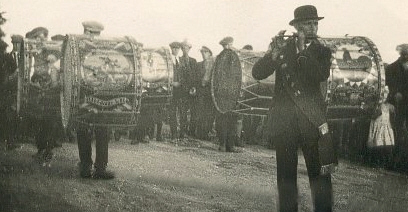Black-clad figures with muffled faces skitter through a courtyard, swarming over walls like spiders and running lightly across rooftops, quick as cats.
An unsuspecting samurai sleeps peacefully as these shadows permanently silence his body guards. The bedroom door slides open without a sound, an up-raised blade glints in the moonlight, and...
This is the ninja of the movies and comic books, the stealthy assassin in black robes with magical abilities in the arts of concealment and murder.
This wraith-like being is very compelling, to be sure. But what is the historical reality behind the popular culture icon of the Ninja?
It is difficult to pin down the emergence of the first ninja, more properly called
. After all, people around the world have always used spies and assassins.
Japanese folklore states that the ninja descended from a demon that was half man and half crow. However, it seems more likely that the ninja slowly evolved as an opposing force to their upper-class contemporaries, the
, in early feudal Japan.
, the ninja's art of stealth, began to develop between 600-900 A.D. Prince Shotoku, (574-622), is said to have employed Otomono Sahito as a shinobi spy.
For a century or more, the blend of Chinese and native tactics that would become ninjutsu developed as a counter-culture, without rules.
It was first formalized by Daisuke Togakure and Kain Doshi.
Daisuke had been a samurai, but he was on the losing side in a regional battle. He lost his lands and his samurai title.
In 1162, Daisuke was wandering the mountains of southwest Honshu when he met Kain Doshi, a Chinese warrior-monk. Daisuke renounced his
code, and together the two developed a new theory of guerrilla warfare called ninjutsu.
, or school, the Togakureryu.
Ninjutsu developed as an opposing force to the samurai code of bushido.
Samurai valued loyalty and honor above all else.
Going into battle, a samurai would select a single opponent, announce his challenge, list his family pedigree, and then attack. Samurai wore bright colors on their armor to announce their clan identity.
Bushido was very noble, but it couldn't always get the job done.
That is where ninjutsu came in: the ninja code valued accomplishing a mission by whatever means necessary. Sneak attacks, poison, seduction and spying were all shameful to the samurai, but fair play by the rules of the ninja.
Who Were the Ninja?:
Some of the ninja leaders, or
jonin, were disgraced samurai like Daisuke Togakure. They had lost in battle or had been renounced by their daimyo, but fled rather than committing
seppuku.
Most ordinary ninja were not from the nobility, though. They were villagers and farmers, who learned to fight by any means necessary for their own self-preservation.
The most famous ninja strongholds were the Iga and Koga Provinces.
Women also served in ninja combat. Female ninja, or
kunoichi, infiltrated enemy castles in the guise of dancers, concubines or servants. They were successful spies, and sometimes acted as assassins as well.
Samurai Use of the Ninja:
The samurai lords could not always prevail in open warfare, but they were constrained by bushido. So, they often hired ninja to do their dirty work.
Secrets could be spied out, opponents assassinated, or misinformation planted... without sullying a samurai's honor.
This system also transferred wealth to the lower classes, as ninja were paid handsomely for their work.
Of course, a samurai's enemies could also hire ninja. As a result, the samurai needed, despised, and feared the ninja, in equal measure.
The ninja "high man," or jonin, gave orders to the
chunin, "middle man," who passed them on to the
genin, ordinary ninja.
Ninja Clothing, Tools and Weapons:
In modern movies and comic books, ninjas are portrayed in all-black clothing, with only their eyes showing.
This costume, however, comes from the
kabuki theater.
Actual ninjas wore navy blue for night operations. Usually, however, they dressed to blend in with their targets - as any sensible espionage agent would do.
Ninja tools and weapons included:
shinobigatana, medium-length swords; the
bo and
naginata, war staves and pikes; and martial arts like karate.
Ninja also developed special equipment like the
shuko, an iron hand-crampon used for climbing, and the
tessen, a sharpened metal fan.
Ninja Techniques:
Ninjutsu is practical; if a tactic is effective, then it is acceptable.
The Eight Methods taught in many
ryu were: Body skills, karate, spear fighting, staff fighting, blade-throwing, use of fire and water, fortification and strategy, and concealment.
Many ninja weapons were modified from farm sickles, saws for wood cutting, pruning shears, etc. If discovered, these items would not give away a ninja's identity.
Among the ninja were expert poisoners. Poison was added to food, or applied to a dart or blade.
Some ninja disguised themselves as flute-playing mystics. The sturdy flute could be used as a club or blow-dart tube.
The Rise and Fall of the Ninja:
The ninja came into their own during the tumultuous era between 1336 and 1600. In an atmosphere of constant war, ninja skills were essential for all sides.
The Nanbukucho Wars (1336-1392)
For more than 50 years in the 14th century, Japan had two separate imperial courts, which fought for control of the country.
The Northern Court was controlled by the shoguns. The Southern Court belonged to Emperor Go-Daigo, who wanted to rule in his own right.
Ninja played an important role on both sides in this struggle, infiltrating castles as spies, and even burning down the South's Hachiman-yama Fortress.
The Northern Court eventually won, and the puppet-Emperor system was retained.
The Onin War (1467-1477)
About 70 years later, the Onin War broke out. Ninja featured heavily in this conflict, as well.
The war began as a succession fight within the ruling Ashikaga clan, but soon devolved into a nation-wide civil war.
Although the Onin War ended after 10 years, it ushered in a century of turmoil called the
Sengoku Jidai, or "Warring States Period" (though it was actually samurai clans fighting, rather than states).
Ninja served a number of purposes during the Sengoku Period (1467-1568). They acted as
kancho (spies),
koran (agitators),
teisatsu (scouts), and
kisho (surprise attackers). They were most effective in castle sieges, infiltrating and distracting the defenders inside while the main besieging army attacked from outside.
Destruction of the Ninja Bases (1581)
The ninja were an important tool during the Sengoku Period, but a destabilizing influence. When war-lord Oda Nobunaga emerged as the strongest daimyo and began to reunite Japan (1551-1582), he saw the ninja strongholds at Iga and Koga as a threat.
Nobunaga's lightning-quick attack on Iga forced the ninja to fight open battles; they were defeated and scattered to nearby provinces or the mountains of Kii.
While their power-base was destroyed, the ninja did not vanish entirely. Some went into the service of Tokugawa Ieyasu, who later became shogun in 1603.
The much-reduced ninja continued to serve both sides in struggles. In one famous incident from 1600, a ninja sneaked through a group of Tokugawa's defenders at Hataya castle, and planted the flag of the besieging army high on the front gate!
Edo and the End
The Edo Period (1603-1868) brought stability and peace to Japan, bringing the ninja story to a close. Ninja skills and legends survived, though, and were embellished to enliven the movies, games and comic books of today.



















